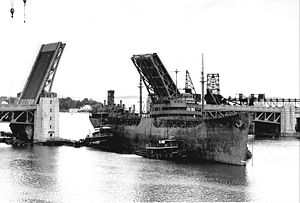USNS Mission San Fernando (T-AO-122)
 USNS Mission San Fernando is under tow as she enters the Quincy, Massachusetts shipyard for conversion to a "Missile Range Instrumentation Ship" in the mid-1960s.[1] USNS Mission San Fernando is under tow as she enters the Quincy, Massachusetts shipyard for conversion to a "Missile Range Instrumentation Ship" in the mid-1960s.[1] | |
| History | |
|---|---|
| Laid down: | 26 August 1943 |
| Launched: | 25 November 1943 |
| Delivered: | 29 February 1944 |
| Struck: | 22 June 1955 |
| Fate: | Converted and renamed |
| General Characteristics | |
| Hull type: | T2-SE-A2 |
| Displacement: | 5,532 tn light; 21,880 tn full |
| Length: | 524 ft (160 m) |
| Beam: | 68 ft (21 m) |
| Draft: | 30 ft (9.0 m) |
| Speed: | 16.5 kt (31 km/h) |
| Complement: | 52 |
| Propulsion: | Turbo-electric, single screw, 6,000 hp |
| Armament: | None |
USNS Mission San Fernando (T-AO-122) was the twelfth of twenty-seven Mission Buenaventura-class tankers built during World War II for service as fleet oilers in the United States Navy. Named for California's Mission San Fernando Rey de España, she was the only U.S. Naval vessel to have borne the name.
Operational history
Mission San Fernando was laid down on 26 August 1943 under a Maritime Commission contract by Marine Ship Corporation of Sausalito, California; launched 25 November 1943; sponsored by Mrs. Ruth B. Krohn; and delivered 29 February 1944. Chartered to Pacific Tankers Inc., for operations, she served the remainder of the War carrying fuel to Allied forces in the western Pacific (during which time she was twice awarded the Navy Battle "E" Ribbon as well as the National Defense Service Medal). She remained in service until 10 May 1946 when she was returned to the Maritime Commission and laid up in the Reserve Fleet at Olympia, Washington. Acquired by the Navy on 21 October 1947, she was chartered to the Union Oil Company for operations and placed in service under the operational control of the Naval Transportation Service as Mission San Fernando (AO-122). Transferred to the operational control of the newly created Military Sea Transportation Service on 1 October 1949 she was redesignated USNS Mission San Fernando (T-AO-l22). She served in MSTS until 24 May 1955 when she was returned to the Maritime Administration and laid up in the Maritime Reserve Fleet at Olympia. She was struck from the Naval Vessel Register on 22 June 1955.
Reacquired by the Navy on 21 June 1956 she was placed in service with MSTS and operated, under charter, by Marine Transportation Lines. She served with MSTS until she was returned to the Maritime Administration on 4 September 1957 and laid up in the Maritime Reserve Fleet at James River, Virginia. Reacquired by the Navy on 28 September 1964 she was taken in hand by General Dynamics for extensive modernization and rebuilding at their Quincy, Massachusetts yard, which included adding 80 feet to her length. While under conversion to a "Missile Range Instrumentation Ship," she was renamed and reclassified as Muscle Shoals (AGM-19). Renamed Vanguard on 1 September 1965 she was placed in service with MSTS on 28 February 1966 as USNS Vanguard (T-AGM-19). Designed to be a seagoing missile tracking station, she participated in the Apollo Project test series and into 1969 had continued in these duties, after which she participated in the Skylab program.
In September of 1980 she was reclassified as T-AG-194. She was reconfigured and the large missile tracking antennas were removed, and her role became that of a "Navigational Test Ship" wherein she was used to check submarine navigation systems. She was stricken again on 12 December 1999. On 29 November 2001 she was transferred to the US Maritime Administration (MARAD). On 16 March 2005 MARAD issued a "Request for Comments" for public input on the historical significance of the Vanguard. As of 30 April 2006 she is anchored in the James River (2nd from right) as part of the James River Reserve Fleet, where her status is listed as "being under historic review."
Notes
- ↑ (PD) Photo: United States Air Force / Dan Kovalchik